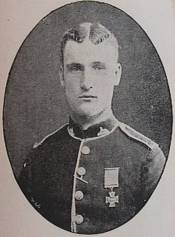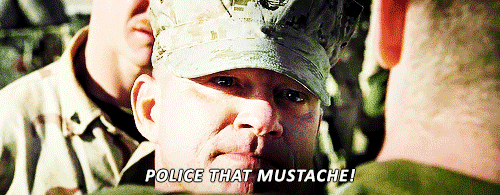Private John William Fielding, VC, also known as Private John Williams.

His citation for the VC:
Private John Williams was posted with Private Joseph Williams, and Private William Horrigan, 1st Battalion 24th Regiment, in a distant room of the hospital, which they held for more than an hour, so long as they had a round of ammunition left: as communication was for the time cut off, the Zulus were enabled to advance and burst open the door ; they dragged out Private Joseph Williams and two of the patients, and assagaied them. Whilst the Zulus were occupied with the slaughter of these men a lull took place, during which Private John Williams, who, with two patients, were the only men now left alive in this ward, succeeded in knocking a hole in the partition, and in taking the two patients into the next ward, where he found Private Hook.
These two men together, one man working whilst the other fought and held the enemy at bay with his bayonet, broke through three more partitions, and were thus enabled to bring eight patients through a small window into the inner line of defence.
He is portrayed briefly as the slightly weedy guy in the hospital who desperately tries to drag Private Hooke away from the medical alcohol cupboard.
It would probably be easier to list the things the movie got right than wrong, but here are some of the more glaring errors.
The 24th wasn’t a welsh regiment at the time, being instead the 2nd Warwickshire Regiment. It only became the South Wales Borderers several years later as part of the Cardwell reforms. A survey of the men of B Company shows that, in common with much of the British army at the time, the majority came from the urban poor of cities like Birmingham or Manchester.
The Zulus did not charge the post at dawn on the second day. They did appear on the horizon, causing considerable concern, but retreated quietly back towards the border. They passed quite close by to the remains of Chelmsford’s Centre Column as they retreated from Ishandhlwana but neither side had the stomach for a fight.
Adendorf, the grizzled Boer who advises Chard throughout the battle, amlost certainly wasn’t there and appears to have deserted his post before the battle. He was only saved from court martial by Chard’s somewhat questionable account of the battle.
The man most likely responsible for organising the fortifications as Rorke’s Drift is Assistant Commisary James Dalton (shown briefly in the film moving around on crutches handing out ammunition). In reality, he was a retired sergeant who had volunteered for service in the commissariat fir the war. He had also rather handily attended a field fortification course at some time in his career.
Hooke as you say was a lifelong teetotaler. His family was somewhat appalled by his portrayal as a malingerer and a drunk and apparently walked out of the film’s premier. It’s possible that his depiction as a drunkard came from a remark he supposedly made after the battle: “after that, I’ll take a drink.”
Bromhead in real life bore little resemblance to Michael Caine’s character in the film and actually bore somewhat of a resemblance to Colour Sergeant Bourne, being tall with a thick, dark beard. He was also somewhat deaf. Bourne on the other hand was rather short and had at one time been the youngest sergeant in the British army. He eventually was commissioned and retired as a lieutenant colonel. Chard was also somewhat unlike the dynamic officer shown in the film. He was actually rather lazy and was seen by many as a bit of a duffer. Sir Garnet Wolsey, the pre-eminent general in the British army at the time was rather unimpressed by Bromhead and Chard when he met them, and is supposed to have said something along the lines of, “two more dull or unimaginative officers, I have never met.” They did their duty when it mattered though.






